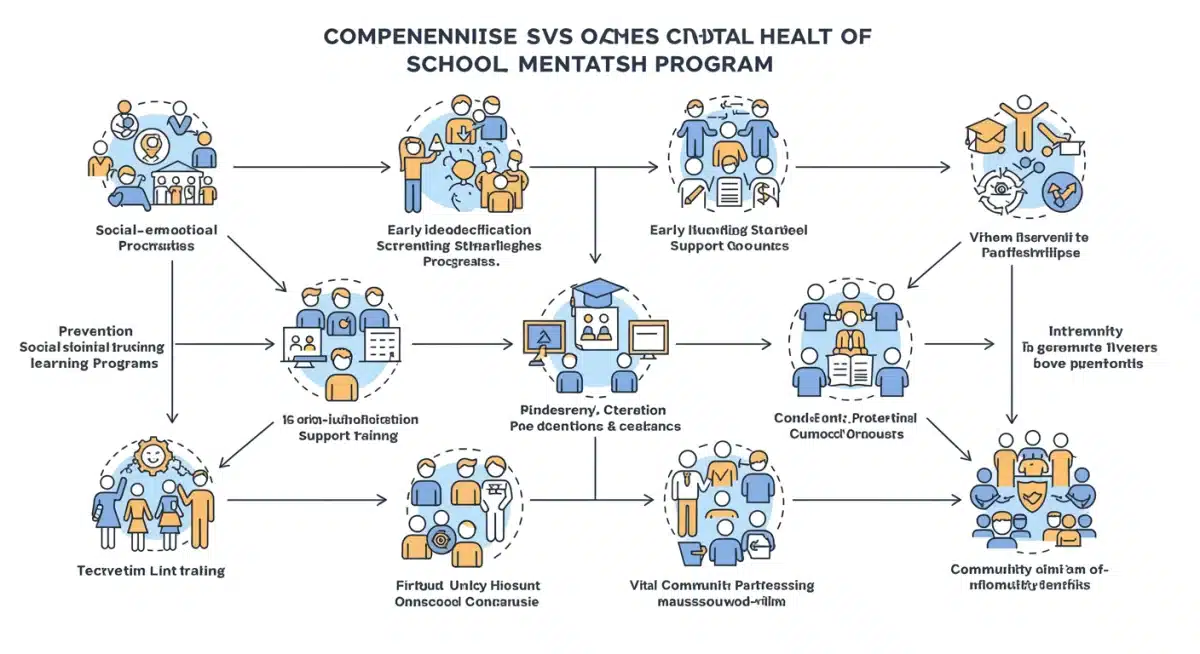Student Mental Health Support: Best Practices for US Schools

Anúncios
By 2025, 30% of US school districts aim to implement best practices in student mental health support, focusing on early intervention, comprehensive services, and a supportive school environment to foster student well-being.
Anúncios
The landscape of education is rapidly evolving, and with it, a growing recognition of the critical role mental well-being plays in academic success and overall student development. The push for student mental health support is not merely a trend but a fundamental shift towards holistic education. By 2025, an ambitious goal aims for 30% of US school districts to have implemented robust best practices in this vital area, significantly impacting millions of young lives.
Anúncios
understanding the urgency of student mental health
The mental health crisis among young people in the United States has reached alarming levels. Statistics reveal a significant increase in anxiety, depression, and other mental health challenges among students, exacerbated by societal pressures, digital influences, and the lasting impacts of global events. Schools are often the first, and sometimes only, point of contact for students in need of support.
Recognizing this, many educators and policymakers are advocating for a proactive approach. Addressing mental health in schools is not just about crisis intervention; it’s about creating an environment where students feel safe, supported, and equipped with the coping mechanisms necessary to navigate life’s challenges. This proactive stance aims to foster resilience and prevent more severe issues from developing.
the growing need for support systems
The pressure on today’s students is multifaceted. Academic rigor, social media dynamics, family challenges, and future uncertainties all contribute to a complex emotional landscape. Without adequate support, these pressures can manifest as poor academic performance, behavioral issues, and long-term mental health conditions. Schools are uniquely positioned to offer a consistent, accessible support system.
- Increased rates of anxiety and depression among youth.
- Impact of social media on self-esteem and body image.
- Academic stress and performance pressure.
- Limited access to external mental health services.
long-term benefits of early intervention
Early identification and intervention are cornerstones of effective mental health support. When issues are addressed promptly, students are more likely to develop healthy coping strategies, maintain academic engagement, and build stronger social connections. This not only benefits the individual student but also contributes to a more positive and productive school community.
Investing in early intervention programs yields significant returns, reducing the need for more intensive and costly interventions later on. It also teaches students the importance of self-care and seeking help, lessons that extend far beyond their school years.
In conclusion, the urgency surrounding student mental health cannot be overstated. By understanding the profound impact mental well-being has on a student’s life and academic journey, schools are better positioned to implement the necessary best practices to support their students effectively.
integrating mental health into school culture
For mental health support to be truly effective, it must be woven into the very fabric of school culture, rather than existing as an isolated program. This means creating an environment where conversations about mental well-being are normal, stigma is reduced, and resources are readily available and visible to all students and staff.
A school culture that prioritizes mental health fosters a sense of belonging and psychological safety, empowering students to seek help without fear of judgment. It also involves training all school personnel, from teachers to bus drivers, to recognize signs of distress and respond appropriately.
staff training and awareness programs
Empowering school staff with the knowledge and skills to support student mental health is paramount. Comprehensive training programs can equip teachers, administrators, and support staff to identify early warning signs, understand common mental health conditions, and know how to refer students to appropriate resources. This creates a network of support throughout the school.
- Mental health first aid certification for educators.
- Workshops on trauma-informed practices.
- Training on recognizing signs of anxiety, depression, and self-harm.
- Strategies for fostering a positive classroom environment.
creating a supportive and inclusive environment
Beyond formal programs, the daily interactions and overall atmosphere within a school significantly impact student mental health. Cultivating an inclusive environment where every student feels valued, respected, and heard is fundamental. This includes promoting diversity, equity, and inclusion initiatives, and actively combating bullying and discrimination.
When students feel a sense of belonging, their mental well-being improves. This sense of community can be fostered through peer support programs, anti-bullying campaigns, and opportunities for student voice and leadership. A positive school climate acts as a protective factor against mental health challenges.
Integrating mental health into school culture requires a concerted effort from all stakeholders. By prioritizing staff training and fostering an inclusive environment, schools can create a foundation where students thrive emotionally and academically.
comprehensive mental health services and resources
Effective student mental health support extends beyond cultural integration to include a range of accessible and comprehensive services. These services should address various levels of need, from universal prevention programs to targeted interventions and crisis support. The goal is to provide a safety net that catches all students who might be struggling.
Developing a multi-tiered system of support (MTSS) for mental health ensures that every student receives the appropriate level of care. This approach includes universal supports for all students, targeted interventions for those at risk, and intensive services for students with significant needs.

in-school counseling and therapy
Having qualified mental health professionals on-site is a cornerstone of comprehensive school mental health services. School counselors, psychologists, and social workers play a crucial role in providing individual and group counseling, conducting assessments, and collaborating with families and outside providers. Their presence ensures immediate access to vital support.
These professionals are often the first point of contact for students experiencing mental health challenges, offering a safe space and expert guidance within the familiar school setting. Their ability to integrate with academic staff also allows for a more holistic understanding of a student’s needs.
partnerships with community organizations
Schools cannot, and should not, bear the entire burden of student mental health alone. Forming strong partnerships with community mental health organizations, local government agencies, and healthcare providers is essential. These collaborations expand the range of services available to students and families, offering specialized care that schools might not be equipped to provide.
- Referral pathways to external therapists and psychiatrists.
- Joint programs for mental health awareness and prevention.
- Access to crisis intervention services.
- Shared resources for family support and education.
Providing comprehensive mental health services and resources is about building a robust support system. Through in-school professionals and strategic community partnerships, schools can ensure that students receive timely, appropriate, and effective care.
leveraging technology for mental health support
In an increasingly digital world, technology offers powerful new avenues for delivering student mental health support. From online screening tools to virtual therapy platforms and educational apps, technology can enhance accessibility, reduce stigma, and provide students with resources in formats they are comfortable with.
The careful integration of technology can extend the reach of mental health services, offering support outside of traditional school hours and to students in remote areas. It also provides opportunities for anonymous access, which can be particularly appealing to students hesitant to seek help in person.
digital tools for screening and early identification
Online screening tools can play a vital role in the early identification of mental health concerns. These confidential assessments allow students to self-report symptoms, providing schools with valuable data to identify those who may need support. When combined with professional follow-up, these tools can significantly improve early intervention rates.
Such tools can also help to destigmatize seeking help, as they offer a private and accessible entry point for students to begin exploring their mental well-being. Data from these screenings can also inform school-wide prevention strategies.
telehealth and virtual counseling options
Telehealth and virtual counseling have emerged as critical components of modern mental health care, especially in school settings. These platforms allow students to connect with licensed therapists remotely, overcoming barriers such as transportation, scheduling conflicts, and a shortage of in-person professionals. This flexibility ensures that support is available when and where students need it most.
- Increased access to specialized care.
- Greater flexibility in scheduling appointments.
- Comfort and privacy of receiving care from a familiar environment.
- Reduced absenteeism due to appointments.
By leveraging technology, schools can significantly enhance their mental health support systems. Digital tools and virtual options provide innovative ways to reach students, ensuring that more young people receive the care they need in a timely and accessible manner.
challenges and solutions in implementation
While the goal of implementing best practices in student mental health support is clear, the path to achieving it is often fraught with challenges. School districts face hurdles such as funding limitations, staffing shortages, and resistance to change. However, innovative solutions and strategic planning can help overcome these obstacles.
Addressing these challenges requires a multi-pronged approach that includes securing dedicated funding, fostering collaborative partnerships, and advocating for policies that prioritize student well-being. It also involves a commitment to ongoing evaluation and adaptation of programs.
funding and resource allocation
One of the most significant barriers to implementing comprehensive mental health programs is securing adequate funding. Mental health services often compete with other critical school needs for limited resources. Solutions include advocating for state and federal grants, seeking private donations, and integrating mental health funding into broader educational budgets.
Creative resource allocation, such as leveraging existing school staff with additional training, can also help maximize impact without requiring entirely new hires. Community partnerships can also share the financial burden and expand available resources.
addressing staffing shortages and training gaps
There is a national shortage of qualified mental health professionals, which directly impacts schools’ ability to staff their programs. Solutions include recruitment incentives, partnerships with university training programs, and investing in professional development for current staff to expand their roles. Additionally, exploring telehealth options can help bridge staffing gaps.
Training gaps can be addressed through ongoing professional development, access to online learning modules, and peer-to-peer mentorship programs. Ensuring that all staff feel competent and confident in supporting student mental health is crucial.
Overcoming implementation challenges requires dedication and strategic problem-solving. By proactively addressing funding, staffing, and training needs, school districts can steadily progress towards achieving their mental health support goals.
measuring impact and ensuring sustainability
Implementing best practices in student mental health support is only half the battle; the other half involves continuously measuring the impact of these initiatives and ensuring their long-term sustainability. Data-driven decision-making is crucial for identifying what works, where improvements are needed, and how to allocate resources most effectively.
Sustainability relies on embedding mental health support into the school’s core mission and securing ongoing commitment from leadership, staff, families, and the community. It’s about creating a system that can adapt and thrive over time.
data collection and program evaluation
Robust data collection and program evaluation are essential for understanding the effectiveness of mental health initiatives. This includes tracking metrics such as student access to services, reduction in disciplinary incidents related to mental health, improvements in academic performance, and student-reported well-being. Regular evaluation allows for continuous improvement.
- Tracking utilization rates of counseling services.
- Monitoring student attendance and academic achievement.
- Conducting student and staff surveys on mental health climate.
- Analyzing data on referrals to external mental health providers.
building long-term commitment and advocacy
Ensuring the sustainability of mental health programs requires a strong, long-term commitment from all stakeholders. This involves ongoing advocacy at local, state, and national levels to secure consistent funding and supportive policies. Educating parents and the wider community about the importance of student mental health also fosters broader support.
Leadership buy-in is paramount; when school leaders champion mental health initiatives, it sends a clear message about their priority. Establishing mental health committees with diverse representation can also help maintain momentum and address evolving needs.
Measuring impact and ensuring sustainability are critical for the success of student mental health support programs. Through data-driven evaluation and continuous advocacy, schools can build lasting systems that truly serve their students’ well-being.
| Key Aspect | Brief Description |
|---|---|
| Early Intervention | Identifying and addressing mental health concerns promptly to prevent escalation. |
| Integrated Culture | Embedding mental health awareness and support into the entire school environment. |
| Comprehensive Services | Offering a range of in-school and community-linked mental health services. |
| Technology Integration | Utilizing digital tools and telehealth to enhance accessibility and reach of support. |
frequently asked questions about student mental health support
Student mental health support is crucial due to rising rates of anxiety and depression among youth, exacerbated by academic pressures, social media, and global events. Schools are often the primary point of contact for struggling students, making in-school support essential for early intervention and overall well-being.
Best practices include comprehensive staff training in mental health first aid and trauma-informed care, fostering an inclusive and supportive school environment, and open dialogues that reduce stigma. This ensures mental well-being is a core part of the school’s daily operations and values.
Technology can enhance services through digital screening tools for early identification and telehealth options for virtual counseling. These innovations improve accessibility, offer confidentiality, and overcome barriers like transportation or staffing shortages, reaching more students effectively and flexibly.
Challenges include limited funding, shortages of qualified mental health professionals, and the need for ongoing staff training. Overcoming these requires strategic advocacy for funding, creative resource allocation, and strong partnerships with community mental health organizations to supplement school-based services.
Sustainability is achieved through continuous data collection and program evaluation to measure impact and identify areas for improvement. It also requires building long-term commitment from school leadership, staff, families, and the community through ongoing advocacy and integrating mental health into the school’s core mission.
conclusion: shaping a supportive future for students
The commitment to enhancing student mental health support in US school districts by 2025 represents a pivotal movement towards a more compassionate and effective educational system. By prioritizing early intervention, integrating mental health into school culture, providing comprehensive services, leveraging technology, and addressing implementation challenges head-on, schools are setting the foundation for a healthier, more resilient generation of students. The journey requires ongoing dedication, collaborative partnerships, and a shared vision that recognizes mental well-being as integral to academic achievement and life success. As more districts adopt these best practices, we move closer to a future where every student has the support they need to thrive, both in and out of the classroom.





